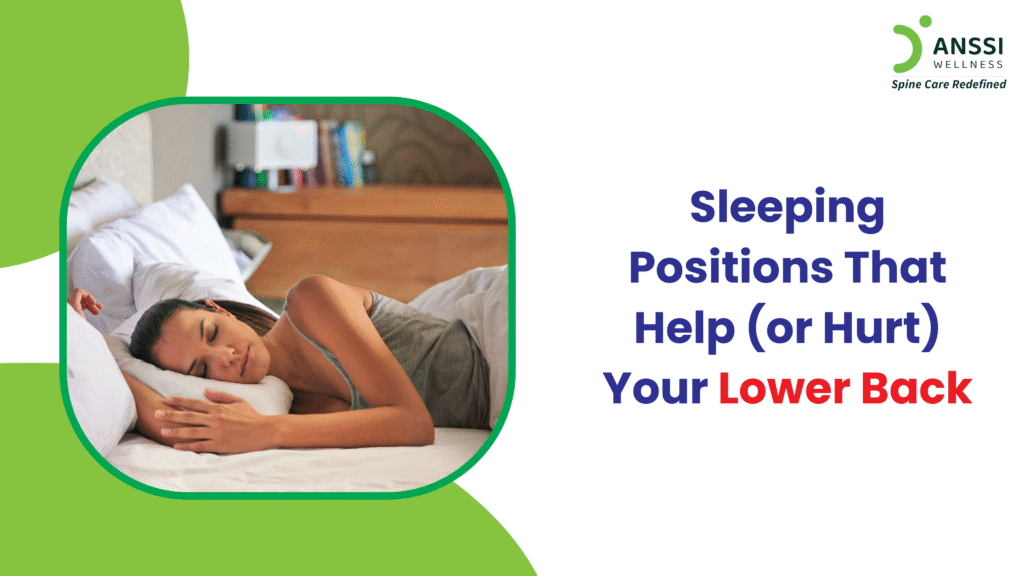A good night’s sleep is essential for your overall health. But did you know your sleeping posture plays a major role in the health of your lower back?
Sleeping in poor positions can not only worsen existing back pain but can also cause new problems over time. Whether you wake up feeling stiff, sore, or refreshed largely depends on how your spine is supported during sleep.
Understanding the right and wrong sleeping positions can make a big difference in managing and even preventing lower back pain.
Why Sleep Posture Matters
While we sleep, our muscles and spine undergo recovery and repair. However, improper alignment during these hours can create or exacerbate spinal issues.
Poor posture while sleeping can:
- Increase disc pressure, leading to disc bulge or herniation risks
- Strain spinal joints and muscles, causing morning stiffness and pain
- Disrupt blood flow, hindering healing and tissue recovery
Maintaining the natural curve of the spine even while lying down is crucial. A neutral spine position reduces unnecessary strain and supports healthy spinal function. This makes it important to not only choose the right mattress and pillow but also to adopt supportive sleeping positions.
Best Sleeping Positions for Lower Back Health
Choosing the right sleeping position can ease existing discomfort and prevent further back problems. Here are the best ways to sleep for a healthy spine:
On Your Back with a Pillow Under Your Knees
Sleeping on your back is one of the best positions for lower back health. Placing a small pillow under your knees helps:
- Maintain the spine’s natural curve
- Reduce pressure on the lumbar discs
- Distribute weight evenly across the body
If possible, use a small, supportive pillow for the neck to keep it aligned with the spine.
On Your Side with a Pillow Between Your Knees
Sleeping on your side is a common and generally healthy position, if done correctly. To optimise this posture:
- Place a firm pillow between your knees.
- Keep your knees slightly bent (not pulled too high toward the chest).
- Ensure your upper body is straight and not twisted.
This technique prevents the top leg from pulling the spine out of alignment, reducing hip and lower back strain.
Fetal Position
The fetal position, where you lie on your side with your knees drawn up toward the chest, can be particularly helpful if you suffer from a herniated disc. It opens up the space between the vertebrae, relieving pressure on the spinal discs.
Tips for proper fetal position:
- Keep the back relatively straight (not overly curled).
- Switch sides occasionally to prevent imbalances.
Reclined Position
For people with conditions like spondylolisthesis, where a vertebra slips out of place, sleeping in a reclined position (slightly propped up) can help. Reclining reduces pressure between spinal segments, allowing for more comfortable rest.
Using an adjustable bed or a supportive wedge pillow can make it easier to maintain this position safely throughout the night.
Worst Sleeping Positions for Lower Back Health
Certain sleeping positions can increase strain on the spine, leading to pain and long-term issues.
Sleeping on the Stomach
This is considered the worst sleeping position for lower back health.
Sleeping on your stomach:
- Forces the spine into an unnatural curve
- Puts pressure on neck joints, leading to neck pain
- Strains lower back muscles
If you must sleep on your stomach, placing a pillow under your hips can slightly reduce spinal stress. But it’s better to train yourself to sleep on your side or back.
Twisted Positions
Sleeping with your spine twisted, such as twisting your torso while keeping your legs straight, places uneven stress on the discs and joints. Over time, this can contribute to spinal misalignment, muscle imbalance, and chronic pain.
Maintaining a straight and supported posture during sleep is key to avoiding these issues.
Tips for Improving Sleep Posture
Small adjustments in your sleep setup can go a long way in protecting your lower back.
Use a Firm Mattress and Supportive Pillows
- Choose a mattress that supports the natural curves of your spine without sagging.
- Use a medium-firm pillow for your head and extra pillows to support knees or hips as needed.
Maintain Consistency
- Try to maintain the same healthy sleeping position throughout the night.
- Avoid frequently switching to stomach sleeping.
Stretch Gently Before Bedtime
- Gentle stretching before sleep can relax tight muscles and promote better spinal alignment.
- Focus on hamstring stretches, pelvic tilts, and gentle back extensions.
About ANSSI:
ANSSI Wellness focuses on improving the quality of life for patients suffering from spinal issues, aiming to provide relief where other conventional treatments have failed. Through advanced non-surgical spinal decompression treatment, ANSSI is committed to helping patients avoid surgery and recover in a safe, effective, and compassionate environment.
Connect with ANSSI Wellness on LinkedIn, Instagram, and Facebook for expert guidance.



